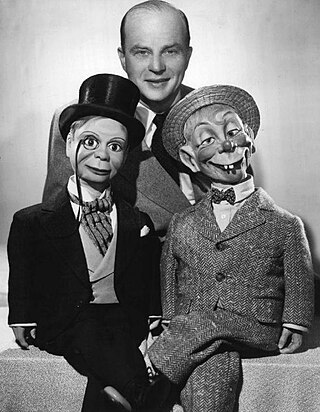| Charlie McCarthy | |
|---|---|
 Charlie (left) with Bergen | |
| First appearance | The Goldwyn Follies |
| Last appearance | The Muppet Movie |
| Created by | Edgar Bergen Theodore Mack Frank Marshall |
| Voiced by | Edgar Bergen (1930–1978) |
| In-universe information | |
| Species | Human ventriloquist mannequin |
| Gender | Male |
| Occupation | Stand-up comedian |
| Home | Smithsonian Institution (After Bergen's Death) |
| Nationality | American |
Charlie McCarthy is famed dummy partner of American ventriloquist Edgar Bergen. Charlie was part of Bergen's act as early as high school, and by 1930 was attired in his famous top hat, tuxedo and monocle. The character was so well known that his popularity exceeded that of his performer, Bergen. [1]
Contents
Charlie's personality was that of a mischievous little boy, who could wisecrack, misbehave and flirt shamelessly in a way that Bergen could not. Bergen's original dummy was built by noted carpenter/dummy-maker Theodore Mack, and was later rebuilt by Frank Marshall. A 1938 magazine article reported that “When Edgar Bergen was a high school student in Chicago in the post-war [WWI] period, he got the notion that he wanted a dummy so that he could become a ventriloquist. He came to Mr. [Charlie] Mack’s workshop who assigned [Frank] Marshall to the problem. Bergen wanted a fresh Irish kid, resembling a newsboy that he knew, and the present Charlie McCarthy was made and sold to Bergen for $35 in 1923. However, it was not until 1933 that Charlie and Bergen breezed into Broadway and were an instantaneous hit which was climaxed by their appearance on the radio.” [2]
Charlie and Bergen made their radio debut on NBC's The Royal Gelatin Hour in 1936, where they proved such a hit that the following year the network gave them a starring role on The Chase and Sanborn Hour , where they were initially supported by emcee Don Ameche, singer Nelson Eddy, [3] actress Dorothy Lamour and comedian W. C. Fields. The following year Charlie would be joined by a much dumber dummy, "Mortimer Snerd". After a famous mock feud with Fields on the program (during which Charlie often vowed to the comedian that he would "mow him down"), the dummy soon became a true icon.
By 1939, Charlie was commanding 35.7% of the audience share [ citation needed ] and was referenced by Barbara Stanwyck in 1945's hit comedy Christmas in Connecticut .
Though shortened to thirty minutes as The Chase and Sanborn Program, it wasn't until 1947, in a rare case of star taking precedent over sponsor in the title, that the series was officially renamed The Charlie McCarthy Show. [4] After a year's hiatus while the duo toured onstage, 1949 brought a switch to CBS and change of sponsors to Coca-Cola. In 1955, Charlie and Bergen entered their last format, with the ventriloquist taking top billing for once, in The New Edgar Bergen Hour, which ran until 1956.
During this lengthy tenure, Charlie's guest roster was filled by many of the biggest stars of the day, including Henry Fonda, the Andrews Sisters, Rosemary Clooney, Roy Rogers, Frank Sinatra, Carol Channing, Groucho Marx, Dinah Shore, Liberace, Bergen's wife Frances Bergen, and in occasional appearances, Charlie's "sister" Candice Bergen. Bergen and McCarthy also co-starred with Mickey Mouse in the 1947 Disney film Fun and Fancy Free . McCarthy also had a cameo in the 1938 Disney cartoon Mother Goose Goes Hollywood , tormenting W.C. Fields, who appeared as Humpty Dumpty.
In 1977, Charlie appeared with Bergen and Mortimer Snerd on Episode 207 of The Muppet Show . Fozzie's dummy "Chuckie" is based on Charlie.
Bergen and McCarthy made their final film appearance in The Muppet Movie , as guest judges of the Bogen County Fair beauty contest. Bergen died in 1978 shortly after filming this sequence, and the film is dedicated to his memory. One of the original Charlie dummies is now part of the permanent collection of the Smithsonian Institution National Museum of American History.













